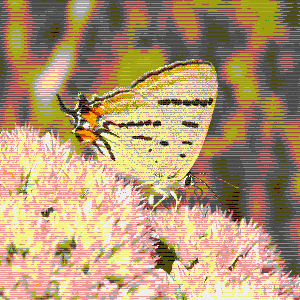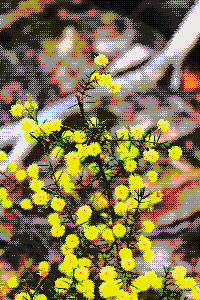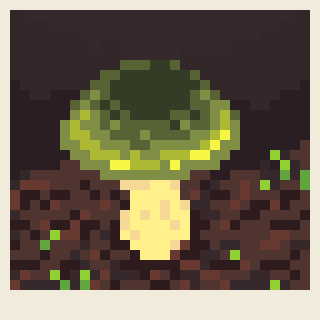grass touching
Look ma I'm a naturalist! Or atleast I'm told that's what the stuff I do makes me. Idk, I just like lookin'n'learnin'. Things you may find here include (but aren't limited to!):
- fungi related schtuff! mushrooms! toadstools! jelly fungi! stinkhorns! slime moulds (yes I know they're not fungi shhhhh they have similar vibes)
- assorted leafy things! eucalypts! wattles! orchids! heaths! mosses! lillies! peas! whatever I can find!
- invertebrates! gosh I do love me some bugs! bees! moths! spiders! beetles! strange parasitic wasps! we got 'em all here
- any larger critters! feathery things! fluffy things! scaly things! spiky things!
Latest:
Jalmenus evagorus - Imperial Hairstreak

The imperial hairstreak is a butterfly in the blues-and-coppers family, Lycaenidae, found across south-eastern Australia. As is typical for members of this family, they are fairly small with a wingspan up to 40mm (to put that into perspective, when perched with wings closed they are fairly similar in size to my thumbnail). The top side of the wings is a shimmery light blue with black borders that is quite eye-catching in flight, escpecially on sunny days. The underside is a creamy pale brown that blends in extremely well with the leaf litter of my local bush, with some sparse black barring. Their coolest features though (in my personal opinion) and certainly their most noticeable, are the bright orange patch with black and white spots on the tip of the hind wing, and their black tails with white tips. Unfortunately this specimen is missing part of the tails, but you can see other examples here. I have read before that the tails may possibly be intended to mimic antennae, with the intention of confusing a predator and directing it away from the real head, giving the butterfly a better chance of escape - which is a pretty neat adaptation!
As is pretty standard for members of the Lycaenidae family, the larvae of this species require specific food plants with particular ant species present to tend them. This is an endlessly fascinating and entertaining approach to life I think - why be so unnecessarily fussy? The imperial hairstreaks are not quite as particular as some of their relatives though. Their larvae feed on a variety of wattles (Acacia species) with fern-like leaves (also called bipinnate leaves), typically younger specimens under 2m tall. In my area, they are usually seen on silver, black, and blackwood wattles (Acacia dealbata, mearnsii, and melanoxylon). Interestingly mature blackwood wattles do not have bipinnate leaves, but they do as juveniles, which would be the main reason why the butterflies favour young plants I assume. THe larvae are protected by ants of the subfamily Dolichoderinae (odorous ants), which defend the larvae from predators in exchange for sugary secretions emitted by the larvae - essentially they're little ant farmers protecting their caterpillar herd so they can 'milk' them for sugar (one of the numerous examples of ants practicing some form of agriculture). This is very cool to watch, although the ants usually become somewhat agitated when I get too close to their bug-cows, and if I linger too long, will start launching a sneaky ground-offensive while I'm distracted by the ones waggling at me from the branches.
This is one of the 18 species of butterfly I'm very proud to have observed visiting my home, and one of even fewer that I've been able to confirm breed here.
Sources and further reading:
- http://lepidoptera.butterflyhouse.com.au/lyca/evagoras.html
- 'Butterflies : Identification and Life History' by Ross Field
Acacia aculeatissima - Thin-leaf Wattle

This is an uncommon species of wattle found across central, western, and south-eastern Victoria (Australia). It is identified by its thin needle-like phyllodes (not leaves! but with a similar function) growing roughly a centimetre long. It has the trademark yellow puff-ball flowers of all wattles, growing on a stem from the leaf-base. It has fairly straight seed pods growing to about five cm long, containing shiny black seeds. It can be distinguished from similar species by it's phyllodes, which can grow pointing either forwards or backwards along the stem. It typically is a small, sparse shrub often trailing along the ground - giving it the alternative name of 'Snake Wattle'. It can be found growing in schlerophyll woodland, forest, and heathland.
I chose it because it was the first plant pic I found when I opened a random folder of photos on my desktop lol. This was observed during the bioblitz last year, in the bush near my town. I don't see these very often, but I think this is largely because they're very inconspicuous and easily walked-past most of the year - however they were all in flower at the time I was out, so I saw several! Some were much larger than I had previously thought they could get (at least in my area anyway). They're not the most spectacular thing in the bush, but I do think they can be kinda neat, and should probably be appreciated more.
Green Skinhead

this is a green skinhead. or my shoddy pixelart version of one. They're kinda slimy and green. there's more I could say about that but I'm just putting this here for layout testing purposes.